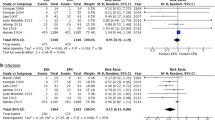Abstract
Purpose
Our previous experimental study of perforated peritonitis in rats proved that peritoneal lavage with strong acid electrolyzed water (SAEW) has no adverse effects, reduces the bacteria count in the ascitic fluid more effectively than saline, and increases the survival rate significantly. Thus, we conducted a randomized controlled study, applying SAEW in the treatment of perforated appendicitis in children.
Methods
Forty-four patients, aged 3–14 years, were randomly divided into two groups: Group S (n = 20), in which the peritoneal cavity was lavaged with 100 ml/kg saline and the wound was washed out with 200 ml saline; and Group E (n = 24), in which the peritoneal cavity was lavaged with 100 ml/kg SAEW and the wound was washed out with 200 ml SAEW.
Results
No adverse effect of SAEW was observed in Group E. There was no difference in the bacterial evanescence ratio of ascitic fluid after lavage between Groups S and E (11.1 and 15.8 %, respectively). A residual abscess developed in one patient from each group (5.0 and 4.2 %, respectively). The incidence of surgical site infection (SSI) was significantly lower in Group E than in Group S (0 and 20 %, respectively; P < 0.05). There was no difference in the duration of pyrexia, positive C-reactive protein, leukocytosis, or hospital stay between the groups.
Conclusion
Peritoneal lavage and wound washing with SAEW have no adverse effects and are effective for preventing SSI.
Similar content being viewed by others
References
Nichols RL. Preventing surgical site infections: a surgeon’s perspective. Emerg Infect Dis. 2001;7:220–4.
Bratzler DW, Hunt DR. The surgical infection prevention and surgical care improvement projects: national initiatives to improve outcomes for patients having surgery. Clin Infect Dis. 2006;43:322–30.
Owens CD, Stoessel K. Surgical site infections: epidemiology, microbiology and prevention. J Hosp Infect. 2008;70(S2):3–10.
Kubota A, Hoki M, Yonekura T, Nose N, Hirooka S, Kosumi T, et al. Effectiveness of acidic oxidative potential water in peritoneal lavage for perforated appendicitis. Asian J Surg. 1999;22:282–3.
Kubota A, Nose K, Yonekura T, Kosumi T, Yamauchi K, Oyanagi H. Effect of electrolyzed strong acid water on peritoneal irrigation of experimental perforated peritonitis. Surg Today. 2009;39:514–7.
Baas Beckking LG, Moor D. Limits of the natural environment in terms of pH and oxidation-reduction potentials. J Geol. 1960;68:243–84.
Hotta K. Acid electrolyzed saline solution: its function and medical application. J Jpn Soc Intensive Care Med. 2000;7:97–105.
Nakagawara S, Goto T, Nara M, Ozawa Y, Hotta K, Arata Y. Spectroscopic characterization and the pH dependence of bactericidal activity of the aqueous chlorine solution. Anal Sci. 1998;14:691–8.
Hotta K, Kawaguchi K, Saitoh F, Saito N, Suzuki K, Ochi K, et al. Antimicrobial activity of electrolyzed NaCl solutions: effect on the growth of Streptomyces spp. Actinomycetologica. 1994;l8:51–6.
Wang L, Bassiri M, Najafi R, Najafi K, Yang J, Khosrovi B, et al. Hypochlorous acid as a potential wound care agent. part I. stabilized hypochlorous acid: a component of the inorganic armamentarium of innate immunity. J Burns Wounds. 2007;6:65–79.
Abe S, Miya Y, Okuda R. Inactivation of hepatitis B virus by high oxidation potential water (in Japanese with English abstract). Jpn J Conserv Dent. 1994;37:1616–23.
Morita C, Sano K, Morimatsu S, Kiura H, Goto K, Kohno T, et al. Disinfection potential of electrolyzed solutions containing sodium chloride at low concentrations. J Virol Methods. 2000;85:163–74.
Tagawa M, Yamaguchi T, Yokosuka O, Matsutani S, Maeda T, Saisho H. Inactivation of a hepadnavirus by electrolyzed acid water. J Antimicrob Chemother. 2000;46:363–8.
Tanaka N, Fujisawa T, Daimon T, Fujiwara S, Yamamoto M, Abe T. The cleaning and disinfecting of hemodialysis equipment using electrolyzed strong acid aqueous solution. Artif Organs. 1999;23:303–9.
Hayashi H, Kumon K, Yahagi N, Haruna M, Watranabe Y, Matsui J, et al. Successful treatment of mediastinitis after cardiovascular surgery using electrolyzed strong acid aqueous solution. Artif Organs. 1997;21:39–42.
Ohuchi S, Kawazoe K, Ishihara K, Izumoto H, Eishi K. Management with closed irrigation for post-sternotomy mediastinitis. Jpn J Thorac Cardiovasc Surg. 2003;51:511–4.
Takemura M, Iwamoto K, Goshi S. Intraoperative irrigation with super oxidation water for perforated appendicitis (in Japanese). Jpn J Surg. 1999;61:1303–5.
Sekiya S, Ohmori K, Harii K. Treatment of infectious skin defects or ulcers with electrolyzed strong acid aqueous solution. Artif Organs. 1997;21:32–8.
Selkon JB, Cherry GW, Wilson JM, Hughes MA. Evaluation of hypochlorous acid washes in the treatment of chronic venous leg ulcers. J Wound Care. 2006;15:33–7.
Acknowledgments
We thank the Functional Water Foundation (Tokyo, Japan) for providing the scientific information on strong acid electrolyzed water.
Conflict of interest
Akio Kubota and his co-authors have no conflict of interest.
Author information
Authors and Affiliations
Corresponding author
Rights and permissions
About this article
Cite this article
Kubota, A., Goda, T., Tsuru, T. et al. Efficacy and safety of strong acid electrolyzed water for peritoneal lavage to prevent surgical site infection in patients with perforated appendicitis. Surg Today 45, 876–879 (2015). https://doi.org/10.1007/s00595-014-1050-x
Received:
Accepted:
Published:
Issue Date:
DOI: https://doi.org/10.1007/s00595-014-1050-x




